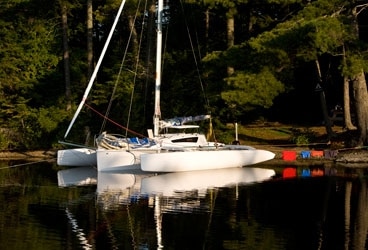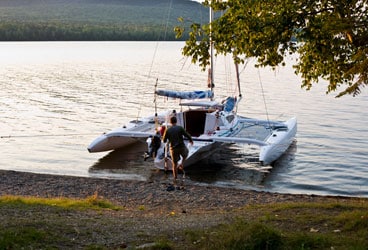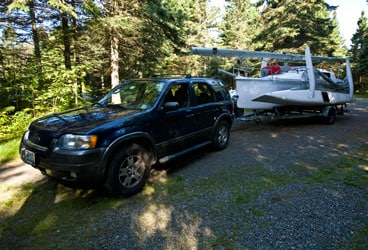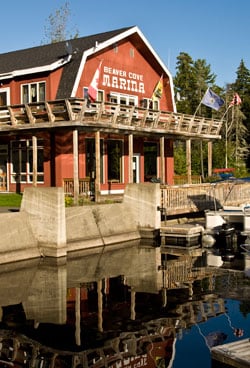
moosehead duck cove 368
The sneaky patch of wind came across the water, catching my wife, Marianne, by surprise. She was driving our 24-foot Corsair trimaran when the puff slingshot the boat’s speed to a casual 14 knots-upwind.
Her eyes bugged out as the wild mustang we were riding bolted from the paddock. Like a cool pro, she pealed the boat downwind as I’d taught her to do when sailing iceboats, turning the heel into afterburner speed. She has iceboating instincts? Cool. I learn something new about her every day.Then our speed rapidly climbed. “Take it!” She tossed the tiller extension at me. So much for instincts, I thought. Since most puffs of wind on an inland lake are short-lived, our speed soon dropped back down to somewhere in the 9- to 10-knot category, still pretty darn good for only 24 feet of waterline. Speed is something I require in the boats I choose to sail, and it certainly seems like a better way to go cruising.
Our trip on Moosehead Lake, Maine, was a little different. It was closer to a wilderness canoe trip. Tents weren’t needed, though, and we covered much more territory. We were sail-camping on a lake in the middle of the Maine woods, home to numerous seaplanes and the famous Maine fishing guides. There were no neat rows of mooring balls to which to tie, nor was there anyone wandering the streets with overpriced cups of coffee in their hand. Boutique fudge shops? No way.
Think loons, tall lodgepole pines, bacon over a campfire, outhouses, soft pine-needle ground cover, lumberjacks, and quiet morning mist across the lake. We were at the edge of the wilderness. In fact, when we first rolled into the town of Greenville, we knew this trip was going to be different. At the town’s only pay phone was a gentleman dressed in camo with a dead bear piled in the back of his pickup. I wasn’t sure which was more unusual: a bear in the back of a pickup or someone still actually using a pay phone.
Greenville, our launching point, was dramatically scenic. As we edged up and over a steep-crested hill, our tri in tow, the lake suddenly came into view and the town appeared in the distance, at its southern tip. At exactly that same scenic spot was the Indian Hill Trading Post, which has all the supplies you could ever want from a supermarket and camping-supply store all in one. Our questions to the staff in the trading post about sail-camping got us some puzzled looks, but they knew the lake area, and their information was a step in the right direction.
Trying to see all of the lake was going to require the entire week. Located in the center of Maine, Moose-head Lake, extending 30 miles north to south and 10 miles wide, is a waterway that doesn’t seem to end, given its endless bays, inlets, hidden coves, and islands. At its southern end, where we launched, summer homes were scattered about, but the farther we traveled north, homes and people grew scarce, and in the quiet bays, the loons were the only residents. Mountains poked their shoulders above the thick forest, their slopes traveling all the way to the water’s edge. It felt as though we’d sailed deep into some faraway wilderness.
Our trip fell nicely into place months before, when I learned that I’d have an extra week of time on my hands. Marianne hinted that we ought to do some cruising. Masterfully plotting moves ahead in her mind like a chess grandmaster, she casually asked me where I’d like to cruise. Not paying too much attention, I must’ve mumbled something about trailering a trimaran somewhere to a big freshwater lake-my dream trip. I know that most cruising types would’ve chosen a destination like Fiji, with its white, sandy beaches, but my heart will always be in the wilds of some sort, so why not try and combine my two loves, sailing and woods? To my utter surprise, she pulled it off, and Bob Gleason of The Multihull Source stepped up to the plate, enthusiastically offering one of his Corsair trimarans for us to use on the trip. This was Christmas Day, and I just got my Red Rider BB gun.
Bob’s headquarters in Wareham, Massachusetts, is multihull ground zero. Scattered about the yard was a wonderful array of boat parts, a new ama here, a faded Hobie TriFoiler there, and two F-27s on trailers, both ready to scream across the water. Inside the boat shop, amid every imaginable piece of nautical hardware, was a place where non-monohull sailors probably hang out, sharing stories of fast sailing. When we found Bob, a few days before we took the trip, he had the multihull-sailor look, too: totally non-yachtie, with his loose-fitting printed shirt, khaki shorts, flip-flops, and a haircut that said I want to sail fast. Bob handed over his new Corsair Dash 750 and told us to have fun.
The Corsair 750 is an amazingly clever boat. From trailer to water, we had it sailing in a fraction of the time I could get previous trailer-sailers under way. Belowdecks, there was a shocking amount of stowage space.
The sailing was swift, even in light air, and when the breeze punched up, it was downright exhilarating. Beating, reaching, and screeching, it was fantastic. Even when the wind didn’t show up to play, it was still great, because the boat had an expansive trampoline between the hulls on which to stretch out and relax, sort of like a couch that hovers above the water.
Monohull cruising and seeing some of the lake would’ve been fun, no doubt, but cruising fast and furious and covering all of the lake was even better. Even in only 7 knots of breeze, there was no fooling around, as the windward ama would rise above the water and spray would peel off the hull.
Covering more ground at a faster-than-normal pace, we had to be on the top of our navigating game and quick about it, especially on a lake that has twists and turns that lead to a few rocky surprises.
Every time I’d look up from the chart, we’d already be half a mile down the track, so it’d need another quick look. At times it felt like I had some kind of compulsive disorder: Glance at the chart. Put it away. No, wait, look at the chart again. OK, got it. Put it away. Whoa, we weren’t here a second ago. Quick! Look at the chart again! We were making trees; it’s a Great Lakes racing expression. If you’re passing the other boat so fast that you start seeing trees on the shore ahead of its bow, you’re doing well.
Honestly, I couldn’t tell you which campsite on Moosehead Lake was our favorite. The trimaran draws only 3 inches of water, so we were able to get into some pretty tight places.

Marianne Lee| |**With the tri safely at rest by the shore of Farm Island, Skipper Mike Lee steps aboard for a beer to help him enjoy the setting sun. ** |
Most afternoons, after hunting down a leeward campsite, we’d pitch the anchor off the bow, then slowly motor in reverse until the stern was close enough to the shore so I could hop in the water and tie the boat to the trees. After settling in, we’d swim in the fresh water, enjoy cold beer, and take naps on the trampoline in the sun. We used the campsite to do our cooking and dining. A crackling campfire as the moon came up would’ve been perfection-had we thought to fill the amas with firewood.
When we came upon the most interesting campsite, we realized that we needed a better approach plan. This site was tucked away in a protected cove with no beach access. But what it did offer was a rocky face that went deep into the water. Rocks like to eat fiberglass. Somehow, tying off to the rock face really didn’t seem like proper seamanship, but the campsite was just too cool to pass up.
We did a little recon, then discussed a strategy to get in there free of scratches. We cautiously made a reverse approach and tied to the rock as neatly as if we were approaching a quiet dockside marina. After we were settled in, I went around and added twice as many dock lines and fenders than were really needed, using a technique perfected by Spiderman. I wasn’t going to feed the rock any of our fiberglass.
Sailing the trimaran was so much fun that it was hard to contemplate non-sailing activities. Nevertheless, Mount Kineo, a scaled-down version of Yosemite’s Half Dome, called out to us. The dock where we landed the tri was essentially the start of the hiking trail. It offered two ways to the top: One was steep and strenuous, and the other-well, we probably should’ve been tied into a climbing rope. This route was definitely not for the white-sneaker hiker.
At the top is a century-old fire tower, and when we saw it, we were certain that it promised majestic views. The tower wasn’t rickety; it just looked as if it was a bit on the thin side. Its stairs did appear to be suspended in air. Even for the acrophilic, it was a “Don’t look down” endeavor. At the top, elevation 1,800 feet, we still couldn’t see the north or south ends of Moosehead. Our hike to the peak was definitely worth passing up a couple of speed reaches across the lake.

Marianne Lee| |With a 24-foot multihull equipped with folding amas finding an open space in an RV camping space was a breeze.|
The week suddenly came to an end, and we were going to have to give the boat back. A lake like Moosehead must be explored, yet sailing it to the top and back in a week’s time would never have happened on board a turtle-hull.
With speed to burn, we actually did more sailing, often choosing to head in whatever direction was the fastest, for the fun of it, rather than trying to get from Point A to Point B. The Corsair’s best feature may be its retractable rudder and daggerboard, which allowed us to camp at some very cool on-the-water sites.
Looking back, I regret that no keelboat sailors were around to envy us as we easily stepped off the stern right onto shore. And I can’t overlook the benefit of its trailerability. Delivery duty on this tri means cruising along at highway speeds, and it made our heads spin with all the new possibilities of waters that we can explore in just a week’s time.
The Corsair was so ideal for us that toward the end of our trip, our conversation kept turning to ways to rearrange our finances so that we could buy it rather than give it back. It’s the perfect tool for the job. We sure do miss it.
Sailing Sources in the Maine Woods

Marianne Lee| |Beaver Cove Marina was a very sailor friendly place to visit. |
Sailor Bill Fletcher and his family run Beaver Cove Marina (www.beavercovemarina.com) just north of Greenville. This full-service marina also has a launch ramp and a secure place to park a car for the week, along with motel rooms and a cabin that can be rented out if you’re not into the camping aspect of this type of sailing trip. Since he took on the manager’s position, Bill’s goal is to promote sailing on Moosehead Lake.
All the supplies you need or forgot to bring from home are at the Indian Hill Trading Post (www.indianhill.com), on Route 15 south of Greenville. Mosquito netting, mint chocolate-chip ice cream, duck boots-they’ve got it all! South of Greenville, to the west on Route 15, is the town’s free launch ramp. It features a large setup area with two slip-free ramps and small docks. This is primarily a ramp for fishermen, but most of those we encountered, very curious about what we were doing with a sailboat, were eager to lend a hand. The 50-foot channel to the ramp is also shared with many seaplanes, which makes for an exciting right-of-way situation. I myself always make the effort to get out of the way of a spinning propeller!
Lifelong sailor Mike Lee has worked in the marine industry for 22 years.







